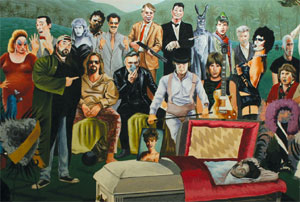Kevin Smith is going to be hosting the opening of a new art show called Crazy 4 Cult next month, and I found the promotional picture for it to be quite interesting:

(click for the full-size version)
Looking at the picture, I recognized a lot of the characters instantly, and some I was able to remember after a little bit of thought. I decided to try to see if I could come up with them all, so I devised this key to use as I went:

(click to enlarge)
Unfortunately, cult film aficionado (and fan of movies in general) that I believe myself to be, I can’t come up with all of them, so I thought I’d ask for help. Below is my list (those listed in bold I’m pretty sure I’ve got right), without looking any of them up in IMDB or anything of the sort; as such, I hope I’ll be forgiven for any misspellings. Can you help me fill in the ones I’m missing?
- Is this from a movie, or just part of the scene?
- Paul Reubens as Pee-Wee Herman (Pee-Wee’s Big Adventure)
- Kevin Smith as Silent Bob (Clerks, et. al)
- Jeff Bridges as Jeffrey “The Dude” Lebowski (The Big Lebowski)
- Sacha Baron Coen as Borat Sagdiyev (Borat: Cultural Learnings of America For Make Benefit Glorious Nation of Kazahkstan)
- Dennis Hopper as Frank Booth (Blue Velvet)
- Patrick Swayze and Keanu Reeves as ??? and ??? (Point Break)
- Sheryl Lee as Laura Palmer (Twin Peaks: Fire Walk With Me)
- Malcolm McDowell as Alexander DeLarge (A Clockwork Orange)
- ??? as Frank (Donnie Darko)
- Christopher Guest as Nigel (This is Spinal Tap)
- Rick Moranis as ??? (Strange Brew)
- Laura Palmer, wrapped in plastic (see #11)
- This looks like Alec Baldwin, but I’m not sure which movie it’s supposed to be from. Or it could be David Lynch.
- Tim Curry as Frank N. Furter (The Rocky Horror Picture Show)
- Like #2, I’m not sure if this is from a movie or just part of the setting of the picture.
- ??? as Chunk (The Goonies)
- This looks like it might be Malcolm McDowell again, but I’m not sure from what.
Massachusettes today shot down an initiative to put a same-sex marriage ban on their 2008 ballot. As such, they remain the only state to have legalized same-sex marriages.
What always gets me about issues like this is how remarkably ignorant the opposition always comes out looking. It’s not just that it’s pompous, idiotic, and against everything that this country supposedly stands for to try to legislate your personal beliefs onto others. It’s also that when you do so, you manage to completely miss the whole point altogether.
“Everybody comes from a man and a woman. That’s the basic fundamental group or unit of society,” said same-sex marriage opponent George Howe, 52. “People get caught up in man-man or woman-woman relationships, they are missing the point.”
I suppose the above would be a valid statement if, in yet another example of Christian beliefs that are not only nonsensical but also downright impossible, “the point” were for every person to procreate. It never once seems to enter into the minds of people like this that “the point” might just be that we–as a people, as a nation, as a society, as a culture–should not stand in the way of each others’ happiness, whenever possible. If what makes others happy does not make sense to you, that’s fine. But it seems like it should be viewed as a much larger and much more detrimental leap than it commonly is for people to then turn and feel justified in using this misunderstanding of others’ happiness as a basis for denying it.
It strikes me as quite ironic that people are so boisterously anti-gay-marriage only a few days after the 40th anniversary of Loving v. Virginia, the Supreme Court case that legalized interracial marriage in this country. The parallels are remarkably obvious to all but the most bullheaded.
As seems to increasingly be the case lately, Penn & Teller make the most sense on this matter. It’s a pity not everybody gets Showtime, but fortunately for those who don’t, the show is available on DVD, and (obviously) highly recommended.
Last night was the bittersweet finale of the best television show ever made, The Sopranos. On one hand, it’s sad to see the show go: no more Sunday night gatherings, discussion, complaining, and speculation (although we can still enjoy the occasional DVD marathon, but without more episodes to look forward to, it just won’t be the same). On the other hand, the series’ last few episodes were at a level that I didn’t think the TV medium could reach: brilliant writing, artful direction, and suspense of a Hitchcockian nature.
After 86 episodes, while I’m disappointed to see the show end, I can say that I’m completely satisfied with its run. It’ll be interesting to see if the movie rumors ever come true. For now, though, I’m happy to bask in reflection of the final episode, as much a masterwork as has ever been broadcast on TV, and as fitting an end to the series as I could imagine.
The series concluded with a recapitulation of its central theme: at the end of the day, no matter what the patriarch’s business might entail, this is still a show about a family (in the traditional sense) trying to survive as best they can. Instead of choosing to meet at any one of the luxurious Italian restaurants we usually see them in, this time they decide to go to a small local diner, Holsten’s, which Tony heralds as having “the best onion rings in the state.” This is a small intimate setting, where Tony will not be distracted or interrupted by members of his other “family”; they are here to simply enjoy each other’s company in a rare time of stability. Tony has escaped death once again, having eliminated his biggest threat, the head of one of New York’s Five Families, Phil Leotardo, with the help of FBI Agent Harris (a relationship that, with this act, has entered into a new realm of trust). AJ has finally found happiness, with a new girlfriend and a new career that seems to be what he was always meant to do (of course, it took a threat to join the Army for his parents to help get him into the movie-making business, but sometimes that’s the way things go). Meadow is set in her career path and poised to start a family of her own–in her earlier conversation with Tony, she nodded in agreement when he mentioned that she’d likely be getting married soon, and then proceeded to explain (to the rare approval of her father) why she’d chosen to become a lawyer. Carmela, as always, is just happy to have a chance to feign at normality for an evening.
This setting, though, serene as it may sound from the above description, manages to serve as the series’ most tense scene. Tony arrives first and selects Journey‘s Don’t Stop Believin’ from the table-top jukebox. As Carmela and AJ arrive and join him, and Meadow struggles to parallel park out front, we are shown various patrons around the diner, all of whom garner nervous glances from Tony. One is an Italian who looks like he might be Phil Leotardo’s nephew, glancing occasionally at Tony from his perch at the counter–is he here to avenge his uncle’s murder? Another is a trucker who looks like he might be a guy Tony and Christopher hijacked once–does he recognize Tony and see an opportunity for justice? A pair of black men enter, and Tony nervously glances up at the sound of the diner door’s chime. They look like the men who had previously been hired to kill him–are they coming for another shot? The Cub Scout troup that was present at the train store when Bobby, Tony’s brother-in-law and then-right hand man, was murdered just an episode ago, is seated in the back. Will they have the misfortune of witnessing the murder of two high-ranking New Jersey mafiosos in as many weeks? As we’re trying to process all of this, wondering what might happen, Meadow continues to struggle with parking her car, and we wonder if one of the other cars outside with her might belong to an accomplice of any one of those inside. Then the man from the counter gets up and heads to the men’s room, evoking memories of Michael Corleone’s first hit, in which he retrieves the pre-positioned murder weapon from the bathroom stall of the restaurant where the crime takes place.
As Meadow finally parks her car and enters the restaurant, the song on the jukebox reaches its crescendo:
Working hard to get my fill
Everybody wants a thrill
Payin’ anything to roll the dice
Just one more time
Some will win, some will lose
Some were born to sing the blues
Oh, the movie never ends
It goes on and on and on and on
And then, as Bobby described to Tony in an earlier episode what he imagines death to be like, “it all goes to black,” and the series is abruptly over. Some might complain that it leaves questions unanswered, but the truth of the matter is that the answers are right there for the viewer’s taking. As the song says, the “movie never ends”; Tony’s life will continue as it has, going on and on and on and on. His children will find their own lives, while he continues to run the New Jersey mob. He can enjoy a quaint meal with his family, but he’s still forever on guard for whoever might be lurking in the next booth. Like the cat that with its legendary nine lives so thematically represented this final episode, Tony will continue to survive. But as the cat also demonstrated with its affection for Christopher’s photograph, nobody is so important as to not be expendable, and so Tony must remain vigilant. Death remains the only escape from the type of life he leads, unless a fate similar to Uncle Junior’s might befall him, losing his memory of all things about “this thing of ours,” and wasting away in a care facility.
The message of this final scene perseveres, though: despite all that has happened, despite the fact that he has just learned that Carlo has indeed flipped and is going to testify against him, despite the fact that his longtime capo Silvio Dante is in critical care, likely never to recover, and several other of the closest and highest-ranking members of his family are dead, Tony’s life continues as it always has, for him and for those around him. Even though our view into this window of the lives of the Sopranos now ends, those lives will continue without us. Some will win and some will lose. It goes on and on and on and on.


